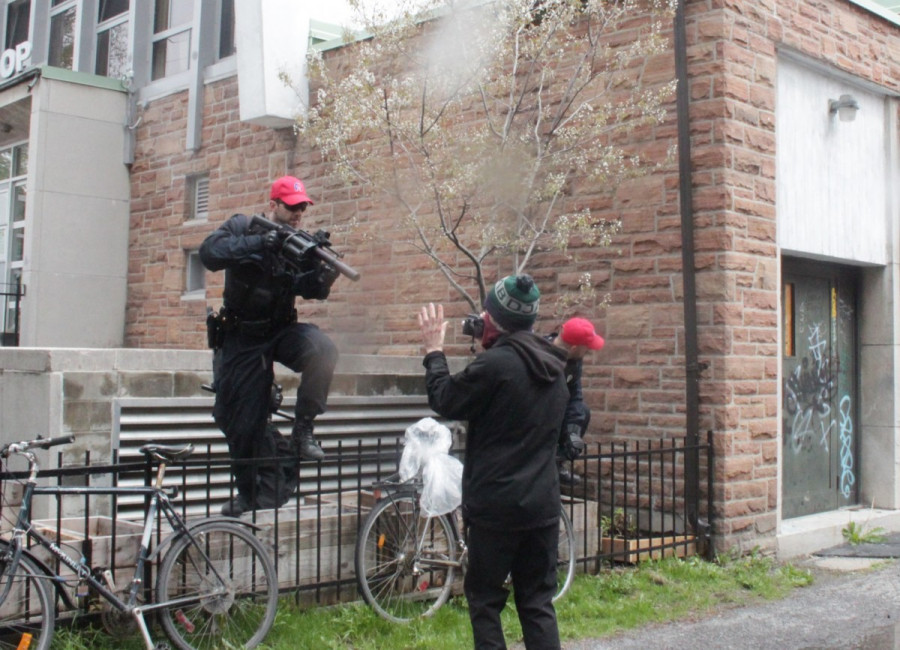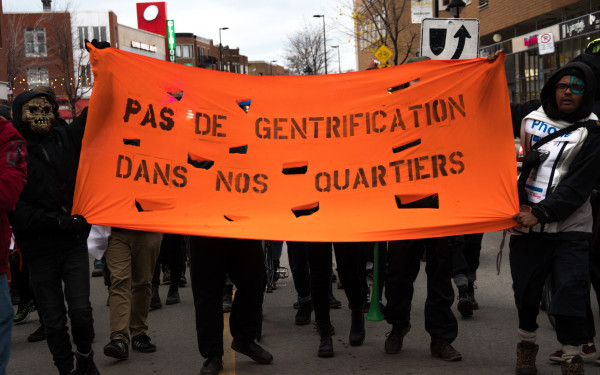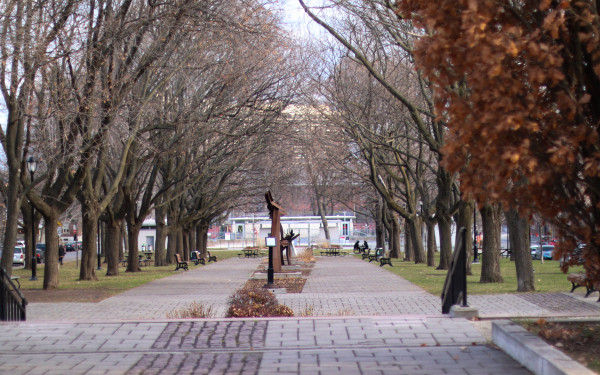Hochelaga Pushes Back to Those Pushing In
Study Says Gentrification is Undeniable in Meeting With Mayor
Gentrification is happening fast in the working-class neighborhoods of Montreal and tensions are running high. In reaction, the population in Hochelaga has begun to mobilize around the issue.
On May 6 and 7, an event was held in Parc Hochelaga, organized by Comité Hochelaguien de lutte anti-gentrification. The festival, which they describe as a “masquerade against gentrification” aimed to facilitate a political discussion with a festive ambiance, including a barbecue for Hochelaga general population.
The weekend included a panel discussion with anti-gentrification activists from all over the city talked about strategies and victories elsewhere in Montreal.
“We believe, as a renter’s right defence committee at Comité [projet organisation populaire information regroupment], that we don’t really have the choice to be uncompromising,” said Patricia Vianney, an activist with the group who spoke on the panel.
“Making compromises, in terms of housing, would imply accepting the construction of condos […] and this brings nothing positive to poorer citizens of the neighbourhood,” Vianney said.
In Pointe St. Charles, St. Henri, Parc-Extension or Hochelaga, those in the working-class are being displaced by more affluent people who are investing in real estate, buying condos, flipping decrepit buildings and opening chic cafés. The rent is then effectively driven up for everyone in the neighbourhood. This, in turn, forces lower income households away.
“When we fight against gentrification, it’s important to remember who the real target is,” said Marco Sylvestro, activist and another panelist. “It’s not the school teacher earning 40k a year who buys a cheap condo because it makes more sense than renting. It’s the real-estate developer who builds these condos who really profits from gentrification.”
CHLAG is a relatively new organization, whose members prefer to stay anonymous. They describe themselves as having a militant and anti-capitalist perspective. They focus their efforts on creating links with different renter’s rights committees in Hochelaga, and communicating their desires through online articles, pamphlets and protests, explained one of its members over the phone.
A study on gentrification by the Institut national de la recherche scientifique shows that it isn’t a simple question of rich versus poor. For example, broke students who move into poor neighbourhoods have what could be described as “cultural capital,” said Sylvestro. Even if they’re short on funds, they are more educated than the traditional population of the neighbourhood, who generally worked in factories and didn’t have access to higher education.
These students usually have more expensive tastes than the workers, and so tend to drive the demand up for expensive goods, like espressos and microbrewery beers, the study says. This makes the neighbourhood appear more attractive to affluent people.
INRS presented their study on gentrification to mayor of Hochelaga, Réal Ménard, on May 7 at Chic Resto Pop, where 120 residents participated in the consultation. There, the crowd discussed different issues around gentrification—such as taxation, social housing and urban development. Each group made a list of recommendations which will be given to Ménard by the end of June.
As part of their festival, CHLAG also organized a demonstration last Sunday to protest the meeting, which they consider to be elitist and inaccessible to the general population. They also criticized it, saying that Ménard is too close to the Société de développement de commerciale Hochelaga-Maisonneuve, and argue he’s only paying lip service to the slowing down of gentrification.
A handful of demonstrators found an unlocked door and managed to enter the restaurant, while others were blocked by a police line at the front door. At this moment, a few riot police who were guarding the front door rushed towards protestors in an attempt to get them out.

This is when police officer Maxime Chartrand-Rioux aimed a grenade launcher at point blank range towards Julien Crête Nadeau, a citizen reporter who was in midst of filming him.
Plastic bullets can cause serious injuries or even death at close range. Chartrand-Rioux never asked Crête Nadeau to move out of his way before aiming his weapon at the reporter.
Journal Métro reported that arrests were made that day. A journalist from Journal Métro was also assaulted by an officer, and a photojournalist was pepper sprayed.
Crête Nadeau said he was fine, but that he was left traumatised from the experience.
Inside, things took a different tone.
“I’m very satisfied by the discussion and so proud to see the citizen implication and participation from the neighbourhood,” said Ménard. “We formally promise to put in place, in a concrete manner, some of the suggestions which were made on this day.”
Deputy Mayor Mathieu Marcotte couldn’t specify which recommendations the city will be keeping in mind, since the sub-committees working on the project havn’t finished their work yet.
According to Émillie Lecavallier, spokesperson for Comité de Base pour l’Action et l’Information sur le logement social, which is Hochelaga renter’s rights defence committee, they did not participate in the consultations because they believe that the borough is wasting precious time. They want to see more social housing and co-ops rather than spend time discussing whether gentrification is happening or whether it is positive.
“We worked with the borough for three years, all they’ve done is this study,” said Lecavallier over the phone. “We know gentrification is happening in Hochelaga, we don’t need to order a new study costing a hundred thousand dollars that’s going to tell us that it’s happening, there’s already plenty of studies on the subject. We don’t want to debate with business owners that gentrification is positive.”
Bâtiment 7: A Trip Down Memory Lane
An example of popular action against gentrification given during the panel by Vianney, is Bâtiment 7, an ancient Canadien National building built in the 19th century when Pointe St. Charles was a hot spot of railway manufacturing in Canada. In 2003, CN stopped its activities in the area, and sold a huge lot to real-estate developer Groupe Mach for the modest sum of $1 and a promise to decontaminate the terrain.
The developer tried to sell the site to Loto-Québec in 2005 when they were planning to move Casino de Montréal from Ile-Sainte-Helene to Pointe-St-Charles. A major mobilization, including protests and land occupation stopped the move.
The site was left abandoned until a group of citizens formed Comité 7 à Nous to pressure the authorities to expropriate the building . They negotiated with Vincent Chiara, Groupe Mach’s president, the borough and the municipal council for years, and managed to buy back Bâtiment No.7 for $1. They also had Chiara donate a million dollars to renovate the building. He also had to decontaminate the site, to respect the earlier agreement taken with the CN.
In April, the cooperative signed the papers, making them officially the owners of Bâtiment 7
They plan to open a microbrewery, a co-op grocery, a co-op makerspace workshop, a birthing centre, a Centre de la petite enfance, and a foundry with Fonderie Darling.
While this is an important victory for residents of Pointe-St-Charles, Sylvestro argues it remains to be seen if the community centre, by opening artist workshops and a microbrewery, won’t create itself so much “cultural capital” that it could in turn attract more affluent people, paradoxically gentrifying it.
“Our objective is to conserve the [radical] political base of the centre,” said Sylvestro.


_600_832_s.png)


3web_600_375_90_s_c1.jpg)

